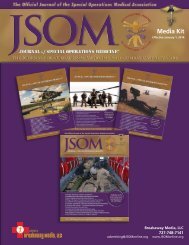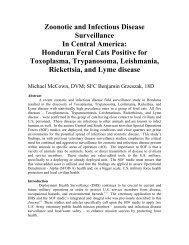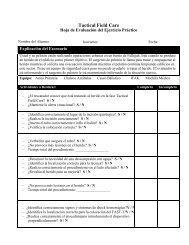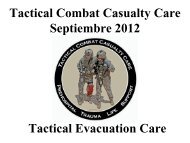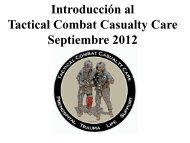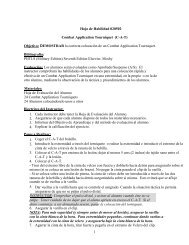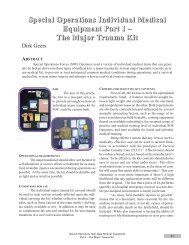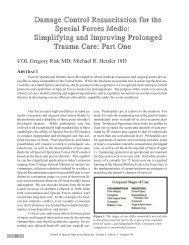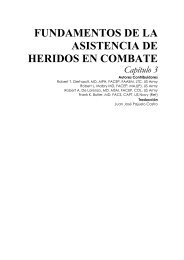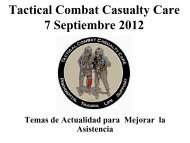Geers D. Special Operations Individual Medical Equipment Part 2
Geers D. Special Operations Individual Medical Equipment Part 2
Geers D. Special Operations Individual Medical Equipment Part 2
You also want an ePaper? Increase the reach of your titles
YUMPU automatically turns print PDFs into web optimized ePapers that Google loves.
as ibuprofen, also interfere with the blood’s ability to<br />
clot and are better replaced by newer types such as<br />
meloxicam. For moderate to severe pain, a stronger<br />
analgesic may be added.<br />
Antidiarrheals<br />
As diarrhea is a very common outdoor problem,<br />
it is important to carry bowel motion inhibitors such as<br />
loperamide. While these only treat the symptoms of diarrhea<br />
and not the underlying cause, their usefulness lies<br />
in the fact that they limit the number of stools, an important<br />
consideration while on the move.<br />
Antiemetics<br />
Antiemetics are especially useful where there is<br />
a risk of dehydration, if vomiting interferes with fluid<br />
intake, or to prevent vomiting (as an anticipated sideeffect)<br />
prior to taking other medication such as some antimalarials.<br />
61<br />
Antitussives<br />
Coughs are a common symptom associated<br />
with respiratory infections that are rarely life-threatening<br />
and usually self-limiting. 62 While symptomatic<br />
treatment may not be medically necessary, tactical considerations<br />
may require antitussives to be carried.<br />
Codeine phosphate is commonly used as an antitussive.<br />
It can also be used as an analgesic (alone or in combination<br />
with acetaminophen, providing stronger analgesia<br />
than either acetaminophen or codeine alone), 63 or to<br />
treat diarrhea. 64,65<br />
Antibiotics<br />
Oral antibiotics to treat (bacterial) diarrhea are<br />
routinely recommended for travelers going to tropical/remote<br />
areas, 66, 67 and often antibiotics for skin infections<br />
and for respiratory infections are recommended<br />
as well. 68,69<br />
Once antibiotic treatment is started, it is important<br />
to take a full course, often continuing for at least a<br />
couple of days after the signs and symptoms of infection<br />
have disappeared. Depending on tablet/capsule size and<br />
the number of daily doses required, this means that antibiotics<br />
can take up considerable space, so ideally, a<br />
single broad-spectrum antibiotic should be selected.<br />
Quinolones such as ciprofloxacin or levofloxacin may<br />
be effective to treat all the aforementioned infections,<br />
but more than one antibiotic may be required in case of<br />
quinolone allergy. 70,71 An additional advantage of<br />
ciprofloxacin is its stability long after the manufacturer’s<br />
expiration date, even under hot and humid conditions.<br />
72 Although included in recommended personal<br />
medical kit lists of several wilderness medicine handbooks,<br />
73 topical eye antibiotics should not be generally<br />
included in individual medical kits, as using them for<br />
the wrong disorder might do more harm than good. 74<br />
Correct self-diagnosis of eye disorders by non-medical<br />
personnel is difficult in the field, and even if the knowledge<br />
was present, several diagnostic items would still<br />
be required. 75<br />
Antihistamines<br />
Antihistamines are useful for treating the symptoms<br />
of allergic reactions, especially after insect bites<br />
and stings. Although some survival manuals recommend<br />
antihistamine cream to be carried, 76 topical antihistamines<br />
can cause skin sensitization and may be less<br />
effective, 77 so it is better to select a long-lasting non-sedating<br />
oral antihistamine (e.g. cetirizine).<br />
Antimalarials<br />
Malaria is an infectious disease that occurs in<br />
those (sub)tropical areas in which Anopheles mosquitoes<br />
are present. Depending on the risk in the operational<br />
area (which may vary according to exact location,<br />
altitude, and season), antimalarials may have to be taken<br />
prophylactically, in addition to other measures, as no<br />
single preventive measure is 100% effective. The exact<br />
type depends on several factors, including the geographical<br />
area and individual tolerance, and will have to<br />
be tailored to each individual. 78 As acute severe falciparum<br />
malaria is a medical emergency, 79 antimalarials<br />
for emergency self-treatment should be carried as well.<br />
They may be different from the drugs to be taken prophylactically.<br />
Oral rehydration salts (ORS)<br />
ORS sachets contain a balanced mixture of dry<br />
salts and carbohydrates, used to treat dehydration and<br />
sodium and potassium depletion due to excessive perspiration<br />
or diarrhea. While glucose-based ORS help<br />
maintain hydration, ORS containing rice-based complex<br />
carbohydrates are a better choice, as they also decrease<br />
stool volume, shorten the duration of diarrhea, and more<br />
effectively promote water absorption. 80-83 (Figure 8)<br />
Figure 8:<br />
Glucose-based<br />
(left) & ricebased<br />
(right)<br />
oral rehydration<br />
salts<br />
6<br />
Journal of <strong>Special</strong> <strong>Operations</strong> Medicine Volume 10, Edition 1 / Winter 10



